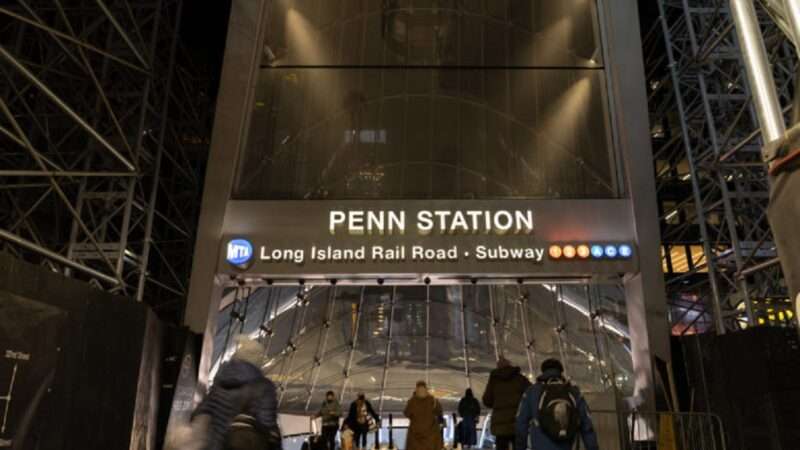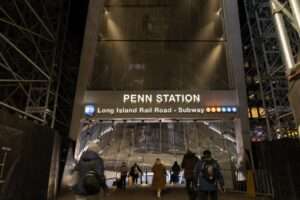

The New York Times has a helpful article on how New York's broad definition of "blight" has enabled the state to declare the area around Penn Station in New York City to be declared blighted, and therefore open to the use of eminent domain to condemn property for transfer to private interests:
The congested, chaotic section of Manhattan near Pennsylvania Station, which teems with tourists, commuters and shoppers, is undeniably drab. Does that make it blighted?
New York State has decreed that it is, and Gov. Kathy Hochul has recently likened the Penn Station area to "a Skid Row neighborhood." She was defending the controversial plan to allow developers to build 10 towers around the decrepit train station — the busiest transit hub in the nation — in exchange for some of the $7 billion the state needs to renovate it.
If New York State officials deem an urban area to be "blighted," blocks can be bulldozed and people and businesses can be forced to relocate. And new towers — unbound by limits on size and height as defined by the city's normal planning rules — can rise.
The state's authority to make such a determination and move forward with redevelopment is nearly impossible to contest….
Over the past 15 years, dozens of states have placed limitations on when they can take ownership of private property. But not New York State, which has among the fewest restrictions on its power to rebuild areas in the name of economic development, according to the Institute of Justice, a libertarian policy group that tracks the issue.
To many people, a "blighted" area would be dilapidated, if not beyond repair; the term conjures up images of vacant buildings, overgrown lots and lawlessness. But as defined by the State of New York, the label is both vague and all-encompassing. It can include conditions like traffic congestion and excessive density that would describe much of New York City….
For the Penn Station project, state officials have staked their claims of blight on "substandard and insanitary conditions" and "economic stagnation." The evidence to support those claims was outlined in a neighborhood study commissioned by Empire State Development, the agency overseeing the project and facing the lawsuit from its opponents, and completed by a civil engineering firm in February 2021.
In the 240-page neighborhood report, the firm explored the exterior and interior conditions of every property in the redevelopment area, assigning ratings for each site. The buildings were found to be older, with many built before 1932, and generating lower rental revenue than their peers in surrounding neighborhoods….
Richard Emery, a Manhattan lawyer who represents opponents of the redevelopment project, noted that the state's own assessment found only eight of 61 lots met the definition of blighted. In contrast, the state deemed more than 70 percent of the Atlantic Yards area of Brooklyn to be blighted before it was redeveloped with the Barclays Center, which opened in 2012.
Even under the state's broad definition of "blight," only a small minority of the lots in the area qualified. But that was enough to condemn the whole thing.
To add insult to injury, much of the supposed "blight" was actually in a part of the area owned by a private firm that may benefit from the use of eminent domain if the redevelopment designation goes through:
Some properties with faulty conditions or unresolved violations are owned by Vornado Realty Trust, the neighborhood's largest landowner, which the state has said will develop some of the new towers. Vornado, a public company that is among the city's largest owners of offices, has accumulated more than a dozen properties in the area over the last 20 years, holding onto them in anticipation of a larger redevelopment.
Of the eight sites that would be redeveloped, Vornado owns four of them and a share of another. The sites could give rise to some of the tallest buildings in the city.
In fairness, it is not yet clear to what extent eminent domain will be used in this case. But the redevelopment plan put forward by the state government is likely to require the demolition of numerous existing structures, including a variety of businesses and a 150-year-old Catholic Church.
This is far from the first time New York has used its blight statute to authorize dubious uses of eminent domain, including in situations where private parties who owned some of the "blighted" property stood to benefit. In a 2011 article, I went over two state Court of Appeals decisions that upheld even more abusive land grabs (the Court of Appeals is New York's highest court). Sadly, little has changed since that time.
Both the New York state constitution and the Fifth Amendment federal constitutions only permit the use of eminent domain to take property for a "public use." But the state Court of Appeals has interpreted that to permit the taking of "blighted" property for transfer to private interests under the state's incredibly broad definition of blight. For its part, the US Supreme Court has ruled—in misguided decisions likeBerman v. Parker (1954) and Kelo v. City of New London (2005)—that virtually any potential public benefit qualifies as a "public use."
In addition to harming local property owners, such condemnations often actually destroy more economic value than they create. Among other things, rendering property rights insecure undermines incentives to invest, and thereby impedes longterm economic development. I go over these dangers in detail in my book The Grasping Hand: Kelo v. City of New London and the Limits of Eminent Domain.
In this case, some beneficial development may occur because—as the Times notes—the "blight" designation can enable the state to get around local restrictions on the height and type of new buildings that can be constructed. Building restrictions are indeed a serious problem curtailing valuable development in New York and elsewhere. But the right approach to this problem is simply to abolish or at least loosen the restrictions without simultaneously authorizing the use of eminent domain.
In the aftermath of the US Supreme Court's controversial decision in Kelo v. New London (2005), many states enacted eminent domain reform laws to curb the taking of property for private development. Some of these laws were effective, others much less so. New York was one of only five states that made no changes at all. It continues to have what may be the most permissive eminent domain law in the entire country.
In 2020, the New York Court of Appeals added to its terrible record in this area by upholding the use of eminent domain to seize property for a pipeline that may never get built. That and the same court's blight precedents bode ill for a recently filed lawsuit (also noted in the Times article) challenging the legality of the Penn Central blight designation.
It's possible that the New York Court will rethink its ultra-permissive approach to public use, or that the state legislature will address the problem, as urged by two dissenting judges in the pipeline case. It is also possible that the federal Supreme Court will overrule or limit Kelo v. City of New London, thereby potentially curbing abusive "blight" and "economic development" takings that transfer property to private interests. Last year, three Supreme Court justices signaled an interest in doing just that. But until one of these things happens, New York's expansive blight designations will continue to facilitate eminent domain abuse.
The post New York's Ultra-Broad Definition of "Blight" Continues to Enable Eminent Domain Abuse appeared first on Reason.com.







